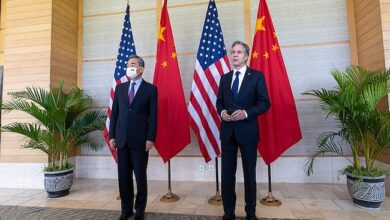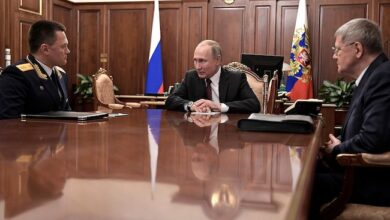Andean anarchy: comparing political crises in Peru and Ecuador

One capital had two presidents, while the other capital had none. In Lima last month, the Peruvian Congress feuded with President Martín Vizcarra and selected an alternative president, creating a situation with two dueling administrations. Meanwhile further north in the Andes, massive protests forced Ecuador’s president to flee from the capital city of Quito. Fortunately, in recent days tensions have cooled in both cities. Vizcarra’s putative rival stood down and acknowledged the president’s legitimacy, while Ecuadorian President Lenin Moreno made a brief fly-by return to Quito in an attempted show of strength. Nevertheless, both countries still have significant turmoil ahead. Going forward, Peru’s crisis has a clearer path to resolution than Ecuador’s.
At its core, the Peruvian chaos stems from a conflict between President Vizcarra and Congress. Vizcarra has clashed with Congress ever since he became president last year. In fact, he only resides in the presidential House of Pizarro because Congress hounded his predecessor into a forced resignation. As a result, Vizcarra’s administration viewed Congress as an existential threat from the outset. During his tenure Vizcarra has clashed with the legislature on everything from corruption policy to judicial appointments. The majority party in Congress, Popular Force, stands in thrall to Keiko Fujimori, a former presidential candidate who currently sits in jail on corruption charges. When Vizcarra proposed a strong anti-corruption bill, Popular Force viewed the measure as a clear danger to their leader and refused to pass the legislation. This obstinance spurred the recent escalation in hostilities- Vizcarra suspended Congress, prompting Congress to promote an alternative president.
Vizcarra appears capable of surviving the crisis because Peru’s congress has a poor reputation. Recent polling indicates that Peru’s legislature has a microscopic 9% approval rating. Local luminaries have backed the president, with Peru’s most famous Nobel laureate, novelist Mario Vargas Llosa, denouncing Congress as “semi-illiterate swindlers.” Vizcarra also hosted Chilean President Sebastian Piñera for a summit meeting this week, indicating that he maintains international support. Most importantly, Vizcarra has secured the backing of Peru’s influential military. Leaders of the four primary armed services- Army, Navy, Air Force, and Police- visited the presidential palace in a show of solidarity with Vizcarra. This military intervention has historical precedent. Peru’s military determined the outcomes of similar crises in the 1960s, 1975, and in 1992, and has again proved crucial for Vizcarra. In fact, this turmoil bumped Vizcarra’s approval rating to a record 82%. Due to Congress’ unpopularity, Vizcarra appears poised to strengthen his position during the upcoming January elections. 
In contrast, Ecuador’s President Moreno does not have such an unpopular foil, and his conflict appears more difficult to resolve. Moreno’s challenges have economic, ethnic, and personal dimensions. Unlike Peru, which has dramatically reduced poverty in the past two decades, Ecuador’s economic slump has accelerated. A combination of low oil prices plus burdensome loans from China have spiraled Ecuador into debt. Ecuador’s oil industry has grown very weak- production recently plummeted and the country actually had to withdraw its membership in OPEC. This debt prompted Ecuador borrow from the International Monetary Fund earlier this year. In exchange for the IMF bailout, Moreno pledged a round of austerity and ended long standing subsidies. Removing these subsidies directly caused the latest unrest- consumers objected to the rising prices and took to the streets to protest Moreno’s policy. The demonstrations have grown increasingly violent, as opposition forces throw rocks at policemen on the streets of Quito and security forces spray teargas in return. The escalating violence forced President Moreno to escape Quito for the southwestern city of Guayaquil, where his Alianza PAIS party enjoys stronger support than it does in the opposition-led capital. However, fleeing to his base’s stronghold seems unlikely to resolve the crisis.
Ethnic politics and personal rivalries further complicate Moreno’s situation. Indigenous groups- representing about a quarter of the population- have led the recent demonstrations. Over 200,000 indigenous citizens have come to Quito from the countryside, lending strength to the anti-government protests. Losing the support of this demographic could have significant repercussions for Moreno and his party. Indigenous voters provided a solid anchor of support for Alianza PAIS last decade, under Moreno’s predecessor Rafael Correa. However, in the 2017 Presidential election, the indigenous community shifted towards the opposition and voted against Moreno. The recent protests have accelerated this trend, which could cost Moreno a key voter base. In addition, Correa has not supported Moreno, his former protege. Correa and Moreno have clashed in recent years, and Correa seems allied with the protests from his semi-retirement in Belgium. In short, Moreno has alienated both a crucial constituency and his political mentor, without actually resolving any underlying economic issues. Although Moreno has maintained support from his military, these economic, ethnic, and political factors leave Moreno much less capable of easing the unrest than his Peruvian counterpart.
The constitutional crises plaguing these two Andean neighbors raise concerns about the state of democracy in South America. Both countries already had significant corruption challenges- Moreno’s 2017 running mate currently sits in prison, and Vizcarra’s six immediate predecessors as Peruvian president have all faced indictment. The recent unrest exacerbates this poor governance. While probably legal, Vizcarra’s decision to unilaterally disband Congress may stretch constitutional norms. Further, the military has played a significant role in propping up both embattled presidents, a policy that has dangerous undertones on this coup-plagued continent. As other nearby countries, such as Brazil, Venezuela, Bolivia, and (soon) Argentina fall to populist demagogues, the region remains short on examples of well run governments. These Andean dramas will accelerate the erosion of trust in political institutions and further weaken global democracy.






